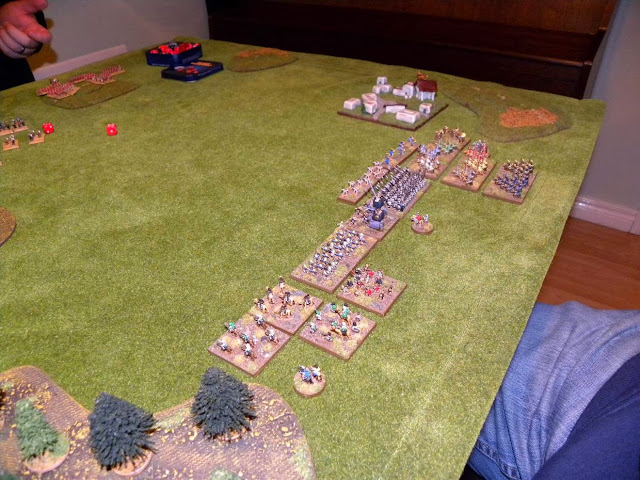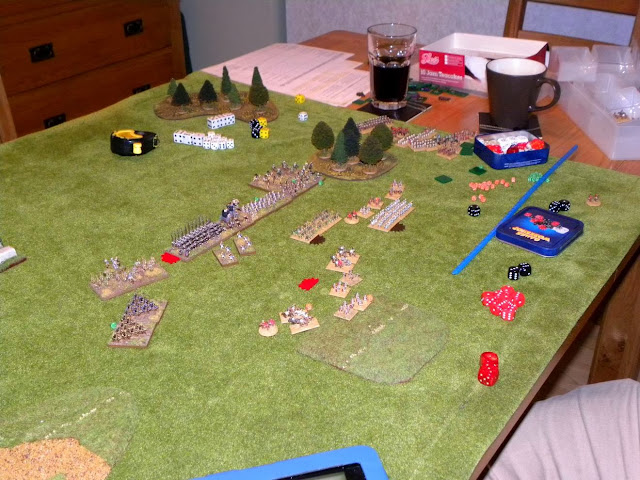"All trees present and accounted for sir!" The Seleukid crown prince aids in preparing the battlefield.
The forced assemble and deploy - Seleukids screen left, Romans screen right.
The Romans:
Left - One Roman legion composed of two units each of velites, hastatii, principes and a unit of triarii. They were led by the army general, Brettius Hodgosus.
Centre - Mounted division composed of one unit each of Roman equites, Italian cavalry and two units of nubile Numidians. Their divisional commander was no doubt of noble birth but history has forgotten his name.
Right - Allied division composed of two units of Italians fighting as legionaries and a unit of Italian hoplites. The leader of the Italians has likewise escaped the notice of historians.
The Seleukids:
Right - The royal cavalry division composed of one unit of elite agema cavalry, two units of heavy xystophoroi cavalry and a unit of light Tarantine cavalry. The right was, as usual, led by King Antiochos personally.
Centre - The royal infantry division composed of one unit each of elite agyraspid pikemen, light infantry archers, Kilikians, Cretan skirmishers, skirmishing slingers and armoured elephants. I'm sure their divisional commander had a Greek name. Lets call him Nikolaos.
Left - Arab auxiliaries composed of one unit each of light cavalry, camelry and light infantry. They were led by a local sheikh known to the court as Zabinas the Arab.
The opening turn saw the nubile Numidians flying across the table to screen the Roman advance.
The Seleukid line watches stoically as the Roman war machine stirs to life.
The Seleukid right and centre surge forward into the plain, tying to broaden their front to engulf the enemy. There was obviously a bit of a language barrier between the commander-in-chief and Zabinas the Arab as the left wing stood around discussing the merits of tea. The photo also makes it clear that the language gap between Latin and Oscan was wider than previously thought as the Italian command on the Roman right likewise had problems advancing.
Zabinas finally gets a move on and heads towards the Numidian horsemen.
The Seleukid line continues a steady advance while the Roman legion out paces its colleagues to the right. The enjoys-a-good-shooting-session half (otherwise known as the left) of the Seleukid line punish the Numidians for coming too close and the sly devils are forced to withdraw.
The Tarantine horse on the Seleukid right trot forward and pepper the legionaries with javelins, attempting to slow up their advance while the rest of the Seleukid cavalry formed up in front of the town.
Roman principes and triarii advance to engage the enemy to their front. The brave Tarentines counter-charge to slow them up for a turn, buying essential time for the Seleukid right.
Meanwhile, the two units of hastatii, supported by velites assault the Seleukid agyraspid pikemen and xystophoroi heavy cavalry. The sacrifice of the Tarentines becomes clearer in the bigger picture as their decision to evade would have seen the Seleukid xystophoroi chewed up and spat out by four Roman units.
Instead, the Tarentines break and run, but so do the hastatii fighting against the Seleukid heavy cavalry.
The Seleukid phalanx forces back the hastatii and velites to their front and as they follow up, are counter attacked by Roman principes supported by Italian horse. On the Seleukid right the heavy cavalry finally forms up, while on the Roman right, the Italians eventually make an appearance. The Arab lights continue to fail to understand that they are requested to go into the woods, not just sit outside them.
The Seleukid elephant-phalanx combo drives back the Romans to their front, routing the principes and shaking and disordering the other units. The Seleukid bow armed lights move forward to reform the central battle line. Two of the Seleukid xystophoroi units start towards the Roman extreme left but do not quite close the gap.
The Italians form a solid line on the Roman right, hoping to punch right through the weak Seleukid archers. However, supported by the elephant corp and Kilikian lights, the archers amazingly hold firm.
On the Roman left, the onslaught of the principes and triarii is too much and one unit of Seleukid heavy cavalry routs while the other is forced back disordered.
Zabinas and Nikolaos got there divisions into a solid (well, almost see-through really) line. Plugging the gaps with light infantry and backing these up with light cavalry and camelry. Nikolaos rallies the archers while Antiochos chats with his xystophoroi about the unhappy consequences of their actions if they choose the withdraw again.
Amazingly, and at great cost, the Seleukid left repulses the Italian attack. The principes and triaii on the Roman left try to assault the worn xystophoroi but do not quite make it into melee, allowing the xystophoroi - led by the king - to counter-charge, hitting the principes alone. The latter collapse in a groaning heap but leave the Seleukid horse in a bad way.
The elite agema cavalry on the Seleukid right seize the opportunity to hit the triarii in the flank.
The Roman veteran infantry crumple on impact and the agema perform a sweeping advance, further obliterating the Italian cavalry.
On their commanders' respective orders, the light infantry unleashed a rain of arrows, sling stones and pointy sticks, driving back the Italian infantry further.
By this stage, the Roman invaders had had enough. With the loss of the triarii and Italian cavalry, both the Roman left and centre collapsed, leaving the Italians on the left with no viable option but to withdraw.
Despite how the photos and write up make it seem, the battle was actually quite a close run thing with several moments throughout where it looked like either of us could have lost. However, as history is written by the victor, I have had the dubious privilege of trying to recall the events of a fantastically fun evening. I am sure we will have a rematch soon enough - and it looks like there will be some Carthaginians joining the fray in the not too distant future. Huzzah for a most enjoyable project!

















































